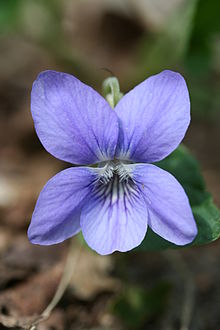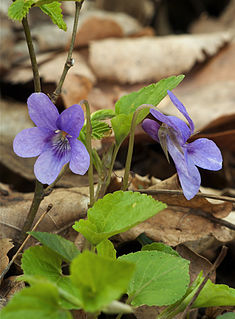
Viola is a genus of flowering plants in the violet family Violaceae. It is the largest genus in the family, containing between 525 and 600 species. Most species are found in the temperate Northern Hemisphere; however, some are also found in widely divergent areas such as Hawaii, Australasia, and the Andes.

Fritillaria meleagris is a Eurasian species of flowering plant in the lily family Liliaceae. Its common names include snake's head fritillary, snake's head, chess flower, frog-cup, guinea-hen flower, guinea flower, leper lily, Lazarus bell, chequered lily, chequered daffodil, drooping tulip or, in the British Isles, simply fritillary. The plant is a bulbous perennial native to the flood river plains of Europe where it grows in abundance.
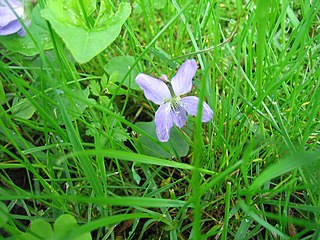
Dog violet is the common name for various species of the plant genus Viola with unscented flowers. The term arose to differentiate them from the scented sweet violet. Species so named include:

Campanula rotundifolia, the harebell, Scottish bluebell, or bluebell of Scotland, is a species of flowering plant in the bellflower family Campanulaceae. This herbaceous perennial is found throughout the temperate regions of the northern hemisphere. In Scotland, it is often known simply as bluebell. It is the floral emblem of Sweden where it is known as small bluebell. It produces its violet-blue, bell-shaped flowers in late summer and autumn.

Anacamptis morio, the green-winged orchid or green-veined orchid, is a flowering plant of the orchid family, Orchidaceae. It usually has purple flowers, and is found in Europe and the Middle East.

The pearl-bordered fritillary is a butterfly of the family Nymphalidae found in Europe and through Russia across the Palearctic to the north of Kazakhstan.
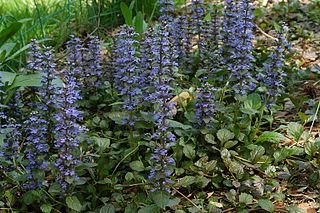
Ajuga reptans is commonly known as bugle, blue bugle, bugleherb, bugleweed, carpetweed, carpet bugleweed, and common bugle, and traditionally but less commonly as St. Lawrence plant. It is an herbaceous flowering plant, in the mint family, native to Europe. It is invasive in parts of North America. Ajuga reptans is also a component of purple moor grass and rush pastures, a Biodiversity Action Plan habitat in the United Kingdom.

Cardamine pratensis, the cuckoo flower, lady's smock, mayflower, or milkmaids, is a flowering plant in the family Brassicaceae. It is a perennial herb native throughout most of Europe and Western Asia. The specific name pratensis is Latin for "meadow".

Silene dioica, known as red campion and red catchfly, is a herbaceous flowering plant in the family Caryophyllaceae, native throughout central, western and northern Europe, and locally in southern Europe. It has been introduced in Iceland, Canada, the US, and Argentina.
In 2002 Plantlife ran a "County Flowers" campaign to assign flowers to each of the counties of the United Kingdom and the Isle of Man. The results of this campaign designated a single plant species to a "county or metropolitan area" in the UK and Isle of Man. Some English counties already had flowers traditionally associated with them before 2002, and which were different from those assigned to them by Plantlife, including the white rose for Yorkshire, the poppy for Norfolk, and the cowslip for Essex. Some flowers were assigned to multiple counties.

Viola palustris is a perennial forb of the genus Viola. It inhabits moist meadows, marshes, and stream banks in northern parts of North America and Eurasia. The species epithet palustris is Latin for "of the marsh" and indicates its common habitat.
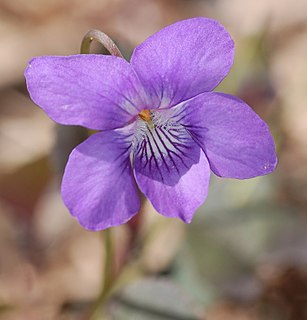
Viola labradorica, commonly known as alpine violet, American dog violet, dog violet or Labrador violet, is a perennial herbaceous flowering plant. It is native to Greenland, eastern Canada, and the eastern United States. The plant sold as Viola labradorica by nurseries is Viola riviniana.

Succisa pratensis, also known as devil's-bit or devil's-bit scabious, is a flowering plant in the honeysuckle family Caprifoliaceae. It differs from other similar species in that it has four-lobed flowers, whereas small scabious and field scabious have five lobes and hence it has been placed in a separate genus in the same family. It also grows on damper ground.

Dalibarda repens(dewdrop, false violet, star violet, Robin runaway. French Canadian: dalibarde rampante) is a perennial plant in the rose family, native to eastern and central Canada and to the northeastern and north-central United States. It is the only species in the genus Dalibarda, which is closely allied with the genus Rubus. The species is often included in the genus Rubus as Rubus repens (L.) Kuntze. It is fairly easily grown in shady locations in damp to wet, acidic soils, and is frequently used in wildflower and bog gardens as a ground-cover.

Viola betonicifolia, commonly known as the arrowhead violet, showy violet or mountain violet, is a small perennial of the genus Viola, which contains pansies and violets. It occurs from India and Pakistan in southern Asia throughout eastern Australia and Tasmania. It grows in shaded habitat in forests.

Viola reichenbachiana, the early dog-violet, or pale wood violet is a flowering plant in the violet family Violaceae.

Polruan to Polperro is a coastal Site of Special Scientific Interest (SSSI) and Special Area of Conservation (SAC) in south-east Cornwall, England, UK, noted for its biological interest. It contains a wide variety of plant species and is a site for populations of breeding birds.

Viola cornuta, known as horned pansy or horned violet, is a species of flowering plant in the violet family Violaceae, native to the Pyrenees and the Cordillera Cantábrica of northern Spain at an altitude of 1,000–2,300 metres (3,300–7,500 ft). It is a low-growing, clump-forming temperate evergreen perennial, reaching 50 cm (20 in) in height and spread. It has mid-green ovate leaves with rounded teeth, and masses of delicate pale violet flowers in early summer. The flower consists of five strap-shaped petals with a slender spur.

Viola calcarata is a species of genus Viola that grows on mountains of south-eastern Europe. It is commonly known as long-spurred violet or mountain violet. It is a herbaceous flowering perennial plant.
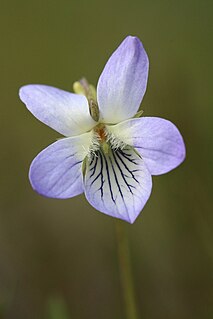
Viola lactea, also known by its common name pale dog violet, is a species of flowering planet of the family Violaceae.
